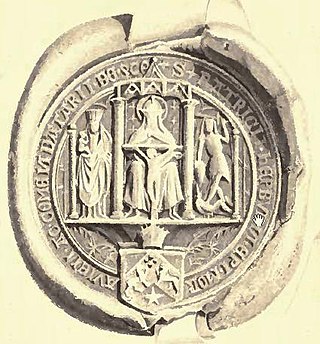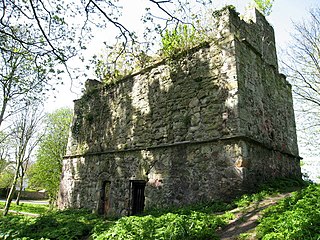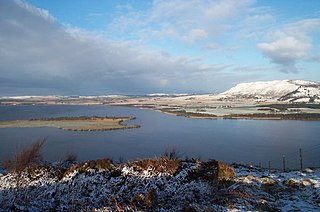Cellach I is traditionally said to have been the first Bishop of the Scots, the bishopric later based at St. Andrews. He is mentioned in the historical writings of Walter Bower and Andrew of Wyntoun as a bishop of St. Andrews, but no pre-15th century sources say anything more than merely "Bishop". Wyntoun and Bower make him bishop as early as the reign of King Giric of Scotland (877x878-885x889). He was still bishop in the reign of King Causantín II of Scotland in 906 when, "in his sixth year King Causantín and Bishop Cellach met at the hill of belief near the royal city of Scone and pledged themselves that the laws and disciplines of the faith, and the laws of churches and gospels, should be kept in conformity with the customs of the Gaels". One interpretation of this passage is the demise of the "Pictish church" to the reforming Gaels, however it is certain that by the 15th century the bishop-list of the principal Scottish see was looking back at Cellach as its first bishop. His death date is unknown, but unsurprisingly he was certainly dead by the 960s when his successor Fothad I died as bishop.
Fothad I is the second alleged Bishop of the Scots (906x955). We know he had the status of "bishop" during the reign of King Dub mac Maíl Coluim because the Chronicle of the Kings of Alba has his death in the period of his reign (962-967). Such a date is supported by the Irish annals, and according to the Annals of the Four Masters, he died in 963. According to the latter source, he was Fothadh, mac Brain, scribhnidh & espucc Insi Alban; that is, "Fothad, son of Bran, scribe and bishop of the islands of Scotland". This entry taken on its own obviously places some doubt on his status as a bishop of St Andrews. It is only because he is mentioned as a bishop of St. Andrews in the bishop-lists of Walter Bower and Andrew of Wyntoun that he is identified with this see; however no pre-15th century sources actually confirm this, although it is true that there was definitely a bishop of this name in the 11th century. Bower, however, gives some explanation, telling us that Fothad "was driven out by King Indolff; and after his expulsion from the see he lived for 8 years". This Indolff, or King Idulb mac Causantín reigned between 954 and 962. If we take both Bower's statement and the obit reported in the Annals of the Four Masters to be correct, this means that Fothad was expelled in 955. Although it is unlikely anyway, he could not have been bishop before the year 906, when we know his predecessor Cellach was still bishop. That he died in 963 as "espucc Insi Alban" allows the possibility that he transferred his see to Iona or elsewhere on the western coast of Scotland after 955, although this is just conjecture.
Máel Dúin is the eighth alleged Bishop of St Andrews. He is mentioned in the bishop-lists of the 15th-century historians Walter Bower and Andrew of Wyntoun as the successor of Bishop Ailín.
Túathal is the ninth Bishop of St Andrews. He is mentioned in the bishop-list of the later medieval historian Walter Bower as the successor of Bishop Máel Dúin. Túathal's name, like his immediate predecessor Máel Dúin's, is known from other sources. A charter preserved in the Registrum of the Priory of St. Andrews, although probably translated into Latin from Gaelic at a later date, records a grant of the lands and church of Scoonie by Bishop Túathal (Tuadal) of St. Andrews to the Céli Dé of Loch Leven. Bower says that Túathal ruled as bishop for four years; as his successor Máel Dúin is known to have died in 1055, this would put his episcopate at roughly between the years 1055/6 and 1059/60. Túathal's immediate successor was the famous Bishop Fothad II.
Cathróe is the twelfth alleged Bishop of St. Andrews according to the bishop-list of Walter Bower. He is one of 4 bishops-elect listed by Bower; that is, he is the second of Giric, Cathróe, Eadmer and Godric. As with the other 3, Bower is our only source. As the list is in chronological order, only Cathróe can have been bishop elect before Turgot of Durham was elected bishop in 1107, with Eadmer being bishop-elect in 1120 after the death of Turgot. It has been suggested too that Eadmer and Godric are the same people.
The Prior of St Andrews was the head of the property and community of Augustinian canons of St Andrews Cathedral Priory, St Andrews, Fife, Scotland. It was established by King David I in 1140 with canons from Nostell Priory, West Yorkshire. It is possible that, initially at least, the prior of St Andrews was subordinate to the bishop as abbot, but by the 13th century the canons of St Andrews were given freedom by the bishop to elect their prior. By the end of the 13th century, the abbacy of the native canons was no longer there to challenge the position of the priory, and the native canons themselves had been formed into a collegiate church.
The Abbot of Kilwinning was the head of the Tironensian monastic community and lands of Kilwinning Abbey, Cunningham, founded between 1162 and 1167. The patron is not known for certain, but it is likely to have been Richard de Morville, Lord of Cunningham. The following are a list of abbots and commendators.

Restenneth Priory was a monastic house of Augustinian canons founded by Jedburgh Abbey, with the patronage of King Malcolm IV of Scotland, in 1153. Although there is little literary evidence, archaeological evidence strongly indicates that there was a monastery at Restenneth from very early times. There is also speculation that Restenneth may even have been the Pictish church dedicated to St Peter built in 710 for Nechtán mac Der Ilei, King of the Picts.
The Prior of May then Prior of Pittenweem was the religious superior of the Benedictine monks of Isle of May Priory, which later moved to the mainland became called Pittenweem Priory. The priory was originally based on the Isle of May, but was moved by 1318 to its nearby mainland site of Pittenweem, Fife, passing from the overlordship of Reading Abbey (Benedictine) to St Andrews Cathedral Priory (Augustinian). The following is a list of priors and commendators:
Donald Elmslie Robertson Watt FRSE was a Scottish historian and Professor Emeritus at St Andrews University.

Patrick Hepburn was a 16th-century Scottish prelate. He served as both pre- and post-Reformation Bishop of Moray.
John Woodman [Wodman] was a 15th-century churchman based in the Kingdom of Scotland. Woodman was a canon of the diocese of St Andrews, and as such was locally made Prior of Pittenweem on the death of the previous prior, James Kennedy, Bishop of St Andrews; however, he was opposed by one Walter Monypenny, while the new bishop, Patrick Graham, desired the position for himself. Woodman had lost litigation for this post to Monypenny by 17 September 1466, and possession to the bishop, though Woodman was still claiming this priory as late as 1477 when he became Bishop of Ross.
Bernard was a Tironensian abbot, administrator and bishop active in late 13th- and early 14th-century Scotland, during the First War of Scottish Independence. He first appears in the records already established as Abbot of Kilwinning in 1296, disappearing for a decade before re-emerging as Chancellor of Scotland then Abbot of Arbroath.

Geoffrey was a 12th-century Anglo-Norman Benedictine monk and abbot. Of Anglo-Norman origin, he became monastic head of the Benedictine priory at Canterbury, before moving to Scotland to be the first Abbot of Dunfermline. As abbot he presided over the construction of the new monastery building, the immigration of English monks and settlers, and the accumulation of enough wealth to make Dunfermline Abbey the richest Benedictine monastic house in the Kingdom of Scotland.

Robert I or Robert of Nostell was a 12th-century Anglo-Norman Augustinian churchman, the first prior of St Andrews.

St. Mary's Priory, North Berwick, was a monastery of nuns in medieval East Lothian, Scotland. Founded by Donnchad I, Earl of Fife around 1150, the priory lasted for more than four centuries, declining and disappearing after the Scottish Reformation. It had been endowed by the Earls of Carrick as well as the Earls of Fife, but over time lost its dependence on these and came to be controlled by the more locally based Home family, who eventually acquired the priory's lands as a free barony.
Walter I was a 12th-century Augustinian Anglo-Norman prelate active in the kingdom of Scotland.
Gilbert was a 12th-century Augustinian canon. Active in Scotland, he may have been of Anglo-Norman origin.
Thomas was an Augustinian canon and Cistercian monk in 13th-century Scotland. According to Walter Bower Thomas was sub-prior of St Andrews Cathedral Priory when he became prior of St Andrews, sometime in 1199. He appears as prior in contemporary documents for the first time on 6 June 1199.

Simon was a 13th-century Augustinian canon based in the Kingdom of Scotland.






